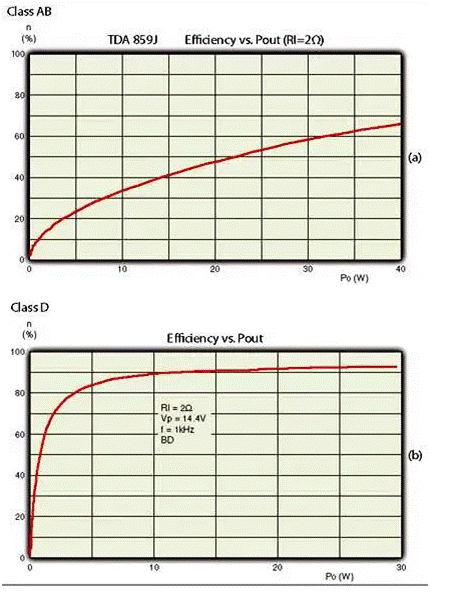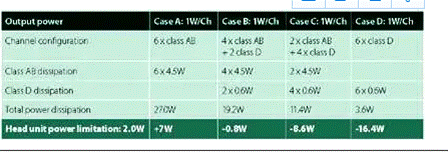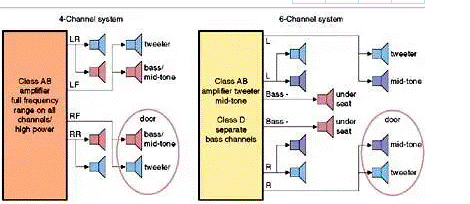Fully utilize Class D amplifiers in your car‘s audio subsystem
Time:2023-04-17
Views:1075
With the addition of more functions and subsystems in automotive entertainment and infotainment systems, the audio power budget of the host and relay units has been pushed to the limit. Car audio designers are looking for a high-performance, cost-effective solution. For many people, using ultra efficient Class D amplifiers wisely is becoming a choice.



Especially, multi-channel and multi speaker systems are becoming increasingly common in high-end cars. The design challenge faced by automotive engineers is to maintain - or even improve - the high audio amplification level and low distortion that customers have always hoped for.
A specific example of the need for higher power is the trend towards high-power, two or even three way speaker systems, and subwoofers.
Unlike audio amplifiers in home entertainment systems, design engineers cannot simply increase power while finding clever ways to control audio quality to achieve these goals. The heat dissipation and space limitations of the host below the dashboard are quite strict.
The power supply voltage is also limited and often interfered by events such as voltage spikes and interference from other electronic and mechanical systems in the car.
Each new model year introduces new subsystems such as video or even navigation and GPS into the audio design space: more speakers, more channels, higher power requirements, and usually less space to accommodate the audio drive system.
The audio power requirements will definitely increase. There are two main methods to meet these needs. The traditional method is to add more channels driven by standard audio amplifiers. This solution has been used in active systems where each amplifier drives a single speaker. But due to the large number of channels, it is becoming increasingly complex and becoming increasingly untenable as a complete solution.
Another method is to increase power output by reducing speaker impedance or using a DC/DC converter to increase power supply voltage. With this solution, a single amplifier can drive two or three speakers while still producing high-performance audio.
Although the second solution is not as complex, both methods have some commonalities: they both increase dissipative power. Therefore, in order to meet power consumption goals, using more efficient amplifiers has become a key part of the solution.

Figure 1: Class D amplifier provides higher efficiency over a wider range than Class AB amplifier.
efficiency
The need for more efficient amplifiers has made the discussion of Class D audio amplifiers a hot topic for audio engineer. With a high efficiency of up to 95% (compared to approximately 50% of Class AB amplifiers), Class D amplifiers can control power budgets and still produce excellent sound.
Their excellent energy efficiency means they require smaller heat sinks, which means there is more space available for electronic devices in the narrow space of the host. However, Class D amplifiers are more expensive than Class AB amplifiers, and they have special design considerations. Figure 1 above shows the relative efficiency of Class AB and Class D amplifiers within a certain output power range.
Please remember that these two methods are not mutually exclusive. In fact, innovative engineering often uses hybrid solutions.
Car audio power is no exception. The design engineer will make decisions based on several key considerations: the size of the host, power requirements, and power dissipation capacity; The cost of audio systems; Audio performance; Reduce interference from other electronic and electromechanical devices.

Table 1 compares the power consumption values of several combinations of Class AB and Class D amplifiers.
Fundamentals of Amplifiers
To fully understand the advantages and disadvantages of Class D amplifiers, understanding different types of amplifiers can be helpful.
*The output device used in Class A amplifiers continuously conducts throughout the entire cycle. In other words, the bias current always flows in the output device. Class A amplifiers provide linear output, resulting in minimal distortion. The disadvantage is that they are inefficient; Their efficiency is usually about 20%.
*The output device of Class B amplifier conducts half a sine cycle (one in the positive region and the other in the negative region). If there is no input signal, there is no current in the output device.
The efficiency of Class B amplifier at output power is 78.5%. However, the time interval between one device turning off and another device turning on can create linear problems at the intersection.
*Class AB amplifiers combine these two types. Both devices conduct electricity simultaneously (although rarely) near the crossover point. The conduction time of each device exceeds half of the entire cycle but is less than the entire cycle, which overcomes the nonlinearity of Class B design.
The efficiency of Class AB amplifier is about 50%, making it one of the common types of power amplifiers at present.
*Class D amplifiers are switch or pulse width modulated (PWM) amplifiers. Due to the switch being either fully open or fully closed, the loss in the output device is greatly reduced. According to reports, the efficiency is between 90% and 95%.
The audio signal is used to modulate the PWM carrier signal of the driving output device. However, due to the fact that Class D amplifiers are switches, they can generate switching noise. It is a low-pass filter that can remove high-frequency PWM carrier frequency.
Class D and Class AB
Class AB amplifiers are the standard for automotive audio applications today, for good reason. This technology is mature and widely known, so application development is relatively easy and does not require adjustments or redesign.
Mass production and fierce competition among multiple IC manufacturers make prices reasonable. The cost of BOM is further reduced as Class AB amplifiers require very few external components.

Figure 2: Comparison of four channel and six channel audio architectures. Adding two channels can drive the bass speaker independently, limit the door resonance and make it possible to have higher fidelity of sound.
When comparing them with the initial product of Class D amplifiers, Class AB amplifiers have the inherent advantage of not generating EMI.
The drawbacks of Class AB amplifiers (50% efficiency resulting in relatively high power consumption and heat dissipation) have become increasingly important as audio systems become more complex.
A new drawback of the audio head unit is that the AB amplifier is not suitable for power supply voltages above 18V to achieve higher output power due to increased power dissipation.
In addition to the benefits of 90% work efficiency, Class D amplifiers can also be designed for digital interconnection with DSP, which processes audio, thereby saving on the cost of DSP integrated ADC. Class AB amplifiers mainly have analog links, but referring to Class D amplifiers as "digital" amplifiers is a misnomer., Class D can be integrated into a 60V distribution main.
Six channel
Most large capacity cars produced today have four audio channels that can power eight speakers. In addition, amplifiers must support the full audio range, and bass and mid-range speakers typically share the same channel and power amplifier. A method that adapts to a four channel configuration will generate resonance inside the door (Figure 2).
Adding two channels can solve several problems. Firstly, it allows high-power bass speakers to be independently driven to the speakers below the front seats of the car through two new channels. Eliminate gate resonance. Higher fidelity of sound is also possible, because all loudspeakers are not obliged to work in the whole frequency range.
However, as any car audio designer will tell you, space and heat dissipation limitations limit the power consumption of the main unit to 20W. The traditional method to solve this problem is to route some speakers to the external amplifier box in the relay unit. Although this solution is feasible, it increases the complexity and cost of the overall system.
The use of Class D amplifiers provides a cost-effective solution. Starting from the traditional amplifier value, an AB amplifier with an efficiency of 55% will consume 4.5W. A Class D amplifier with an efficiency of 94% will dissipate 0.6W.
Using six AB class amplifier channels will result in a total power consumption of 27W -7W more than the commonly believed value of the audio head unit, as shown in Table A.
But even if only two Class D amplifiers are used, mixing the two types of amplifiers can still meet the power budget, which is likely to be used for bass speakers. The bottom row of the table shows the difference between 20W and the total power consumption of a specific configuration.
The cost of Class D amplifiers may make Case B a possible choice for mid range vehicles. However, looking into the future (especially the "audio system" market and the prospect of higher voltage power rails), Class D amplifiers may expand their market penetration.
The vehicle‘s audio system may support at least 8 and up to 22 channels - many of which are located in the relay unit. If a Class D amplifier is not added to the system, supporting a large number of channels will be an almost impossible task.
In the endless equilibration between cost and quality objectives, design engineers will find many combinations of AB and damping. Class D devices will find their initial positions in areas where low power consumption is crucial and (somewhat surprising) applications that require very high power output. These applications include systems with over 90W, among which stereo D-class is very suitable. However, these options may be divided into four categories:
Premium: 8 to 22 channels, driven by a combination of Class AB and Class D, with a target power exceeding 28W/channel;
Midrange optimized for low power consumption: Four to six channels are driven by Class D, with a goal of greater than 25W/channel;
Cost optimized mid range: four to six channels are driven by a combination of AB and D amplifiers;
Basic sound: Two to four channels, all AB driven, target less than 28W channels.
Handling EMI
The automotive environment is extremely challenging for Class D applications. All knowledge and skills of semiconductor suppliers with experience in Class D amplifiers and automotive applications must be applied to design excellent products.
Figure 3: During the dead time between amplifier switch transistors, charges accumulate in the bulk diode and are released as current spikes (shown in red).
Firstly, it is necessary to include I2C control, as it is necessary for automotive design. In addition, challenges have become even more difficult. The output voltage of Class D is influenced by the power supply voltage, for example, the power supply voltage in cars is not constant.
Measures must be taken to suppress the ripple voltage of the power supply. The method to achieve this goal is to use a negative feedback loop. The use of second-order feedback loops can provide excellent ripple suppression.
As mentioned earlier, EMI caused by switches is one of the important D-class problems and is also a difficult problem to solve. At the design level, EMI can be reduced through phase interleaving, frequency hopping, and AD/BD modulation.
The current spike that causes EMI is caused by the dead time between transistors in the amplifier switch. During the dead time, charges accumulate in the body diode and are released as current spikes (as shown in Figure 3, where the red line represents the spike).
The obvious solution is to eliminate dead time. Silicon on insulator (SOI) technology is ideal as all components are isolated by oxides. When the output is below ground potential, there will be no accumulation of charges in the device substrate, thereby reducing reverse recovery time and not causing crosstalk channels to other components.
NXP uses SOI Advanced BipolarCMOS-DMOS (ABCD) technology to manufacture its Class D amplifier. In addition to suppressing EMI, this process has another advantage compared to the bulkBipolar CMOS DMOS (BCD) process - it is not affected by latches, which may damage the device
Class D amplifiers are increasingly entering automotive audio applications and will continue to gain market share. By 2015, they may account for 30% of the automotive audio amplifier market.
|
Disclaimer: This article is transferred from other platforms and does not represent the views and positions of this site. If there is any infringement or objection, please contact us to delete it. thank you! |











